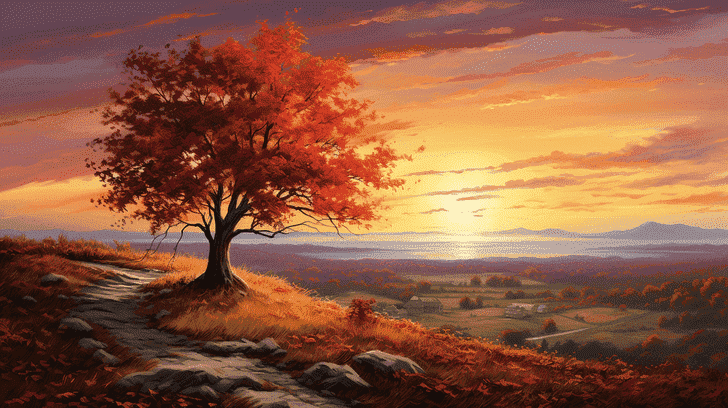Step into the enchanting world of Iowa’s woodlands, where a tapestry of native trees awaits your exploration.
Like a master detective, you will uncover the secrets of these arboreal wonders, armed with the knowledge to identify them by their unique leaf shapes and distinctive barks.
This journey will not only deepen your understanding of Iowa’s natural heritage, but also inspire you to join the noble cause of preserving these woodland treasures for future generations.
Welcome to the realm of Woodland Wonders: Identifying Iowa’s Native Trees.
The Importance of Native Trees in Iowa
You should understand the significant role that native trees play in Iowa’s ecosystem.
Native trees provide numerous ecosystem benefits that contribute to the overall health and stability of Iowa’s natural environment.
Firstly, these trees help to improve air quality by absorbing carbon dioxide and releasing oxygen through the process of photosynthesis.
Additionally, native trees help to regulate water cycles by absorbing rainfall and reducing the risk of flooding.
They also provide habitat and food sources for a variety of native wildlife species, promoting biodiversity and maintaining the delicate balance of the ecosystem.
However, native trees in Iowa face threats and challenges such as deforestation, invasive species, and climate change.
It’s crucial to protect and preserve these trees to ensure the continued provision of ecosystem benefits and the long-term sustainability of Iowa’s natural environment.
Characteristics of Iowa’s Native Trees
Native trees in Iowa exhibit unique characteristics that contribute to their adaptability and resilience within the local environment. Iowa’s tree population is diverse, consisting of various species with different growth patterns.
Some trees, such as the Bur Oak, have a slow growth rate but can live for several hundred years. Others, like the Black Walnut, grow relatively fast and provide valuable timber. The Eastern Red Cedar is known for its ability to tolerate drought and poor soil conditions.
Iowa’s native trees have developed specific adaptations to thrive in the state’s climate, such as deep root systems to access water during dry periods. Understanding these characteristics is crucial for proper management and conservation efforts to ensure the continued health and abundance of Iowa’s tree population.
Common Native Tree Species in Iowa
The most common native tree species found in Iowa include the White Oak, Sugar Maple, and Red Maple. Understanding the growth patterns of these trees is essential for successful identification and management.
Here are some key points to consider:
- Growth patterns:
- White Oak: This hardwood tree typically reaches heights of 60 to 100 feet and has a broad, spreading crown. It grows at a moderate rate and can live for hundreds of years.
- Sugar Maple: Known for its vibrant fall foliage, the Sugar Maple grows to be about 60 to 75 feet tall. It has a dense, rounded crown and exhibits a slow to moderate growth rate.
- Red Maple: With a rapid growth rate, the Red Maple can reach heights of 40 to 60 feet. It has an upright, oval-shaped crown and adapts well to various soil conditions.
Exploring the environmental impact of these native trees reveals their significance in Iowa’s ecosystem. They provide habitat and food for wildlife, contribute to carbon sequestration, and help maintain soil stability. Additionally, their foliage provides shade and helps cool urban areas, reducing energy consumption.
Identifying Native Trees by Leaf Shape and Bark
An article about identifying native trees by leaf shape and bark can provide helpful guidance for distinguishing different species in Iowa. Tree identification techniques that focus on leaf shape and bark characteristics can be valuable tools for amateur botanists and nature enthusiasts alike.
When examining leaves, it’s important to observe their shape, size, arrangement, and venation patterns. For example, the leaves of the bur oak have a distinct lobed shape, while the leaves of the black walnut are compound and pinnately arranged.
Bark can also reveal important clues about a tree’s identity. Some trees, like the white oak, have smooth and light-colored bark, while others, like the shagbark hickory, have distinctive shaggy bark.
Conservation Efforts for Iowa’s Native Trees
You can contribute to the conservation efforts of Iowa’s native trees by participating in tree planting initiatives and supporting local organizations dedicated to preserving the state’s natural resources. By getting involved, you can help protect and restore Iowa’s native tree populations, ensuring their survival for future generations.
Here are three ways you can make a difference:
-
Join tree planting initiatives: By actively participating in tree planting events, you can help increase the number of native trees in Iowa’s landscapes. These initiatives focus on planting tree species that are native to the region, ensuring their suitability for the local environment.
-
Support local organizations: Many organizations in Iowa are devoted to preserving the state’s natural resources, including its native trees. By supporting these organizations through donations or volunteering, you can contribute to their efforts in conserving and restoring native tree populations.
-
Raise awareness: Spread the word about the threats to Iowa’s native tree populations. Increased awareness can lead to greater support for conservation initiatives and help address challenges such as deforestation, invasive species, and climate change that pose significant risks to the survival of native trees.
Conclusion
In conclusion, understanding and appreciating Iowa’s native trees is essential for their conservation and the overall health of our environment.
By recognizing the characteristics of these trees, such as their unique leaf shapes and bark patterns, we can better identify and protect them.
Conservation efforts are crucial in preserving these woodland wonders and ensuring their presence for future generations.
So, step into the fascinating world of Iowa’s native trees and embark on a journey of discovery and conservation.

